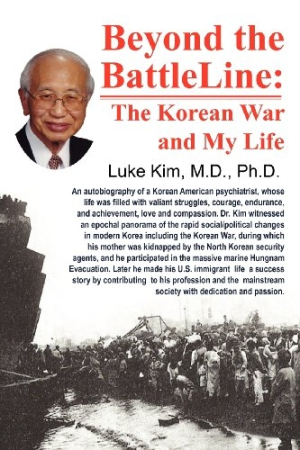Beyond the Battle Line
The Korean War and My Life
In popular legend there’s a curse: “May you live in interesting times.” Luke Kim’s life has misfortunes, and the distinguished Korean-American physician has certainly lived in interesting times. In Beyond the Battle Line, he covers the historic sweep of that life in a straightforward, modest manner.
The book tells the story of Kim’s professional and personal life, and shares his reflections on heritage and family history. Approximately half the pages focus on Kim’s life narrative, with the remainder related to his accomplishments in psychiatry, psychology, and education.
Born in 1930 in the northern port city of Sinuiju, when pre-divided Korea was an Imperial Japanese protectorate, Kim was drafted into Imperial Japan’s war effort. In the latter stages of World War II, a teenage Kim did forced labor in an ammunition factory. Readers might want more depth, but Kim relates these hard times factually, with an enviable stoicism.
Kim’s family was Christian, converted in the early twentieth century by American missionaries, and faith anchored his life. Readers can reflect on the unwritten here—Eastern ethos blended with Christian faith—but again, Kim is straightforward rather than reflective.
This early period is the most interesting segment of Beyond the Battle Line. Few contemporary readers have any idea of the social and cultural mores of Korea during that era. The hardships his family suffered while never neglecting their goal to educate their children are mind-boggling. Also intriguing is Kim’s insight into the Korean independence movement under Japanese oppression.
After the war, the Kim family fled from Communists to Seoul, capital of South Korea. When the Communist army overran the south, his father was away from home. His mother was kidnapped by Communist agents—because of the family’s political and religious beliefs—and disappeared into the abyss of oppression. Kim worked as an interpreter for United Nations forces, playing a part in the massive military and humanitarian evacuation at Hungnam after the Chinese crossed the Yalu River. The author is modest, but it is apparent lives were saved by his work. He later served in the Korean navy and marines during the war, before being released to pursue medical studies.
Kim earned a medical degree in Korea, came to the United States to earn a PhD in psychology and became certified in psychiatry. He intended to return to Korea to work with a mentor, but that professor died. Kim stayed in America, leading a distinguished professional life.
Kim writes clearly, with informational rather than literary technique. There are few grammatical errors, but not enough to distract. Readers should expect extensive exposition and Korean names and references. Kim has incorporated maps into the narrative as an aid, and there are photographs, including those of Kim’s ancestors and progeny.
Kim’s book will be a worthy addition to the library of readers interested in personal interpretations of contemporary history. It will certainly make a contribution as reference material for Asian-American immigrant cultural studies.
Reviewed by
Gary Presley
Disclosure: This article is not an endorsement, but a review. The publisher of this book provided free copies of the book and paid a small fee to have their book reviewed by a professional reviewer. Foreword Reviews and Clarion Reviews make no guarantee that the publisher will receive a positive review. Foreword Magazine, Inc. is disclosing this in accordance with the Federal Trade Commission’s 16 CFR, Part 255.

